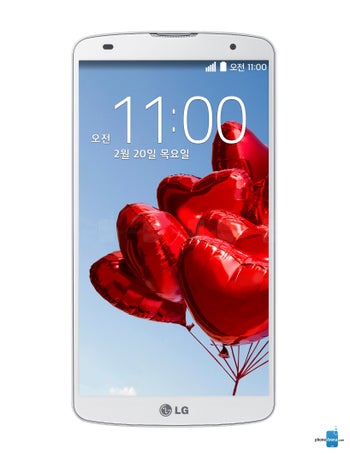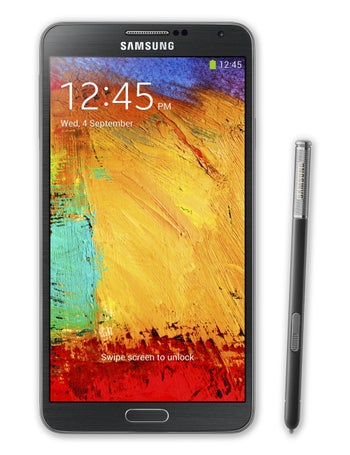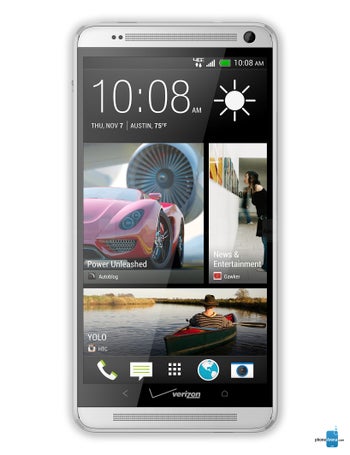LG G Pro 2 vs Note 3 vs HTC One max specs comparison

LG just lifted the veil over its largest phablet to date, the G Pro 2, and the handset is everything that it was rumored to be - large and resolute display, keys on the back, fast Snapdragon 800, generous 3 GB of RAM and a 13 MP shooter with a newer OIS breed.
How does it compare to the other high-end phablets out there? Let's see, on one hand it is taller and somewhat wider than the Note 3, but sports the same slim chassis, and has a 0.2" larger screen to boot, so LG definitely did well here. That's especially visible in comparison with the other brand name 6-incher - HTC One max - which is way taller, wider, thicker and heavier than the G Pro 2 even. Granted, HTC had to accommodate its excellent BoomSound dual speaker system at the front, and a fingerprint sensor on the back, but still. LG and HTC flaunt LCD displays, while the Note 3 keeps it AMOLED, but these three companies have proved they can put excellent panels on their flagships, so you are unlikely to regret your purchase when it comes to screen quality.
In terms of processing power, the G Pro 2 is an exact match to the Note 3, with the fastest current Snapdragon 800 processor, and the record 3 GB of RAM, while the One max makes do with a lower-class Snapdragon 600, and 2 gigs of RAM. The faster phablets also offer the generous 32 GB of internal storage from the get-go, against HTC's 16 GB, but they all have microSD slots for storage expansion - one has to carry all those movies somewhere.
LG G Pro 2 shines in the camera department as well, as it is the only one offering a 13 MP shooter with improved optical image stabilization tech inside, putting an end to blurry shots and shaky footage. The Note 3 also carries an excellent 13 MP unit, but without OIS, while the One max tags along with HTC's UltraPixel shooter that is somewhat light in the detail department, due to its comparatively low resolution.
HTC's phablet excels a tad in the battery capacity department, offering 3300 mAh unit, against the 3200 mAh juicer in the other two, but in reality the difference is likely to come from overall consumption rates, rather than battery capacity. Overall, LG did great with the G Pro 2, offering top-shelf specs in what can be considered a compact body, as much as it is possible with a 6-incher, so it will definitely be on the radar of those looking for a good big-screen handset, unless you are bent on the input options that come with Samsung's Note 3 stylus.
|
|
|
|
| LG G Pro 2 | Samsung Galaxy Note3 | HTC One max |
| Dimensions | ||
|---|---|---|
| 6.22 x 3.22 x 0.33 inches 157.9 x 81.9 x 8.3 mm |
5.95 x 3.12 x 0.33 inches 151.2 x 79.2 x 8.3 mm |
6.48 x 3.25 x 0.41 inches 164.5 x 82.5 x 10.29 mm |
| Weight | ||
| 6.07 oz / 172.0 g | 5.93 oz / 168.0 g | 7.65 oz / 217.0 g |
| Materials | ||
| Back: Aluminum | ||
| Biometrics | ||
| Fingerprint (swipe) | ||
| Features | ||
| Stylus, Interchangeable covers | Touch sensitive control keys | |
| Keys | ||
| Back: Volume control, Lock/Unlock key | Left: Volume control; Right: Lock/Unlock key | |
| Colors | ||
| Black, Gray, Red, White | Black, Pink, White | |
| Size | ||
|---|---|---|
| 5.9-inch, 74.27% screen-to-body | 5.7-inch, 74.78% screen-to-body | 5.9-inch, 70.63% screen-to-body |
| Type | ||
| IPS LCD | Super AMOLED | S-LCD 3 |
| Resolution | ||
| 1920x1080px, 373 PPI | 1920x1080px, 386 PPI | 1920x1080px, 373 PPI |
| Colors | ||
| 16 777 216 | ||
| Protection | ||
| Corning Gorilla Glass 3 | Corning Gorilla Glass 3 | |
| System chip | ||
|---|---|---|
| Snapdragon 800 MSM8974 | Snapdragon 800 MSM8974 | Snapdragon 600 APQ8064T |
| Processor | ||
| Quad-core 2260 MHz Krait 400 | Quad-core 2300 MHz Krait 400 | Quad-core 1700 MHz Krait 300 |
| GPU | ||
| Adreno 330 | Adreno 330 | Adreno 320 |
| Memory | ||
| 3GB/32GB | 3GB (LPDDR3)/64GB 3GB/32GB |
2GB (LPDDR2)/32GB 2GB/16GB |
| Storage expansion | ||
| microSDXC up to 64 GB | microSDHC up to 64 GB | microSDXC up to 64 GB |
| OS | ||
| Android (5.0 Lollipop, 4.4) | Android (5.0 Lollipop, 4.4.4, 4.4, 4.3) | Android (4.4.2, 4.4, 4.3) |
| Type | ||
|---|---|---|
| 3200 mAh | 3200 mAh, Li - Ion | 3300 mAh, Li - Polymer |
| Rear | ||
|---|---|---|
| Single camera | Single camera | Single camera |
| Main camera | ||
| 13 MP (OIS, Autofocus) Aperture size: F2.4 Focal length: 29.22 mm Sensor size: 1/3.06" | 13 MP (Autofocus, CMOS image sensor, BSI sensor) Aperture size: F2.2 Focal length: 31 mm Sensor size: 1/3.06" Pixel size: 1.12 μm |
4 MP (Autofocus, BSI sensor) Aperture size: F2.0 Focal length: 28 mm Sensor size: 1/3" Pixel size: 2 μm |
| Flash | ||
| LED | LED | LED |
| Video recording | ||
| 4K UHD (30 fps) HDR | 4K UHD (30 fps), 1080p (60 fps), 720p (120 fps) Continuous autofocus, Video light, EIS, Video calling |
1080p (30 fps), 720p (60 fps) HDR, Continuous autofocus |
| Front | ||
| 2.1 MP Video capture: 1080p | 2 MP Video capture: 1080p | 2.1 MP Video capture: 1080p |
| Bluetooth | ||
|---|---|---|
| 4.0 | 4.0 | 4.0 |
| WLAN | ||
| a,b,g,n,ac,dual-band Hotspot, Wi-Fi Direct 802.11 a, b, g, n, ac | a,b,g,n,ac,dual-band Wi-Fi Direct, Hotspot 802.11 a, b, g, n, ac | a,b,g,n,ac,dual-band Wi-Fi Direct, Hotspot 802.11 a, b, g, n, ac |
| USB | ||
| microUSB, USB 2.0 | microUSB, USB 3.0 | microUSB, USB 2.0 |
| Sensors | ||
| Accelerometer, Gyroscope, Compass, Ambient light sensor, Proximity sensor | Accelerometer, Gyroscope, Compass, Thermometer, Gesture, Humidity, Barometer, Ambient light sensor, Proximity sensor | Accelerometer, Gyroscope, Compass, Ambient light sensor, Proximity sensor |
| Hearing aid compatible | ||
| T3 | ||
| HDMI | ||
| Yes | Yes | |
| Location | ||
| GPS, A-GPS, Glonass | GPS, A-GPS, Glonass | GPS, A-GPS, Glonass |
| Other | ||
| NFC, Infrared, Tethering, Computer sync, OTA sync | NFC, ANT+, Infrared, Tethering, Computer sync, OTA sync | NFC, Infrared, Tethering, Computer sync, OTA sync |
| Headphones | ||
|---|---|---|
| 3.5mm jack | 3.5mm jack | 3.5mm jack |
| Speakers | ||
| Earpiece, Loudspeaker | Earpiece, Loudspeaker | Earpiece, Multiple speakers |
| Features | ||
| Album art cover, Background playback | Album art cover, Background playback, Preset equalizer | Album art cover, Background playback |
| Screen mirroring | ||
| DLNA,SlimPort | DLNA,MHL | DLNA,MHL,TV-out |
| Radio | ||
| FM, Stereo, RDS | ||
| Additional microphone(s) | ||
| Noise cancellation | ||
| LTE Bands | ||
|---|---|---|
| 3, 7 | 2, 3, 4, 5, 8, 17, 18 | 3, 7, 8, 18 |
| 3G Bands | ||
| 8, 1 | 5, 8, 2, 1 | 1, 2, 8 |
| Data Speed | ||
| LTE Cat 4 (150/50 Mbit/s), HSDPA+ (4G) 42.2 Mbit/s, HSUPA 5.76 Mbit/s | LTE Cat 4 (150/50 Mbit/s), HSDPA+ (4G) 42.2 Mbit/s, HSUPA 5.76 Mbit/s, UMTS | LTE, HSDPA+ (4G) 42.2 Mbit/s, HSUPA 5.76 Mbit/s, UMTS |
| SIM type | ||
| Micro SIM | Micro SIM | Micro SIM |
| VoLTE | ||
| Yes | ||
| Notifications | ||
|---|---|---|
| Haptic feedback, Music ringtones (MP3), Polyphonic ringtones, Vibration, Flight mode, Silent mode, Speakerphone | ||
| Other features | ||
| Voice dialing, Voice commands, Voice recording | ||
| FCC approval | ||
|---|---|---|
| Date approved: Nov 07, 2013 FCC ID value: A3LSMN9005 | Date approved: Sep 30, 2013 FCC ID value: NM80P3P100 | |
| Measured SAR | ||
| Head: 0.24 W/kg Body: 0.72 W/kg Simultaneous Transmission: 1.07 W/kg Wireless Router: 1.04 W/kg |
Head: 0.95 W/kg Body: 0.51 W/kg Simultaneous Transmission: 1.58 W/kg Wireless Router: 0.51 W/kg |
|
| EU SAR | ||
| Head: 0.29 W/kg | ||
| Officially announced | ||
|---|---|---|
| Feb 12, 2014 | Sep 04, 2013 | Oct 14, 2013 |
See the full
LG G Pro 2 vs Samsung Galaxy Note3 vs HTC One max specs comparison
or compare them to other phones using our
Phone Comparison tool
Follow us on Google News

















Things that are NOT allowed:
To help keep our community safe and free from spam, we apply temporary limits to newly created accounts: